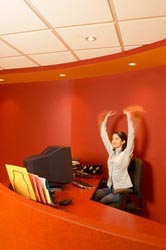Computer-Related Injuries on the Rise:
Important Tips to Stay Safe
by www.SixWise.com
Computers have become a mainstay in most American households and in many homes there are more than one. They’ve even expanded out of the home office to bedrooms and in some cases, the kitchen counter.
|

As computer use increases, so too do computer-related injuries.
|
These electronic devices that are now a part of your home décor can be helpful and handy tools … as well as the cause for recent emergency-room visits. New research revealed that the numbers of patients winding up in emergency rooms for computer-related accidents are on the rise.
Data gathered from the U.S. Consumer Product Safety Commission’s National Electronic Injury Surveillance System showed that approximately 78,000 people experienced computer-related injuries over a 13-year time period.
The Hazards Lurking in and Around Your PC
According to most recent statistics from the U.S. Census Bureau, the number of U.S. homes with computers shot up from 15 percent to 62 percent from the years 1989 to 2003.
“It’s a pretty significant problem, given that computers are in most homes these days and many homes have more than one,” said study author Lara McKenzie, an assistant professor of pediatrics at Nationwide Children’s Hospital in Columbus, Ohio in a Yahoo News article.
Four Common Home Computer-Related Injuries
-
Tripping over computer wires or getting whacked by falling equipment jumped from about 1,300 cases a year to 9,300 a year. This reflects an increase of 732 percent nationwide
-
The most common injuries were the arms or legs
-
Head injuries were the leading injury among young children
-
The most common injury among all age groups were lacerations (39 percent) followed by contusions and abrasions (23 percent)
Based on the results from the study, experts said you could reduce the likelihood of these injuries by following these safety tips.
-
House your computer on a wide, durable desk or work area and position it away from walk areas
-
Keep all cords secure and organized and out of walk areas
-
Maintain your work area by making sure it is clean and orderly. Also, place sliding outlet covers on all unused and used electrical outlets. These simple-to-install covers protect pets and children from exposed outlets. They are spring activated, so they automatically cover outlets when any plug is removed.
-
Be sure to anchor down any heavy furniture and check that computer parts are fastened securely to the wall
|
Get Up From Your Computer
Chair and … Stretch!
 Rates of heart disease, diabetes and obesity are doubled and even tripled in people who sit a lot. So if you spend long hours sitting in front of your computer, it’s important to work in some much-needed physical activity. Rates of heart disease, diabetes and obesity are doubled and even tripled in people who sit a lot. So if you spend long hours sitting in front of your computer, it’s important to work in some much-needed physical activity.
Stretching is an excellent alternative to sitting, and Stretching Toward a Healthier Life on DVD gets our top recommendation for five key reasons:
Find out more about Stretching Toward a Healthier Life with FREE SHIPPING for a Limited Time!
|
Computers at the Office Can be an Occupational Hazard
Long periods of staring at the computer screen for an average of eight hours a day combined with poor posture can result in eye strain along with many other overuse injuries of the upper limbs such as muscle and joint pain.
The most common incidences of computer-related injuries surface in the back and neck. Most people may think that when they’re sitting there isn’t much need for muscular effort. The strain stems from a reduction of circulation to the muscles, bones, tendons and ligaments that bring on feelings of uncomfortable stiffness and pain. By changing some inappropriate work habits that you may have fallen into you can reduce the risk of these common injuries.
Important Tips to Keep in Mind When Purchasing Your Chair and Desk
Computer Desk and Chair Must-Haves:
-
Buy an adjustable desk and position your monitor so that it is at eye level or slightly lower. Invest in an ergonomic keyboard to enable you to maintain a natural holding position or buy one that allows you to minimize your mouse usage. Make sure your forearms are positioned parallel with the floor and at the same height as your keyboard.
-
Adjust your chair so that your feet are resting flat on the ground. If your feet don’t rest on the floor, get a footstool.
-
When buying a chair, look for an ergonomic chair to help your spine hold its natural curve. If you don’t have the money to buy an ergonomic chair, be sure the chair you buy is height-adjustable and has lumbar backrests or purchase a lumbar roll for lower back support.
Simple Ways to Prevent Overuse Injuries
Overuse of your upper limbs can be brought on by repetitive movements and poor posture. These injuries usually manifest in the elbow, hand or wrist and can result in pain, swelling, joint stiffness, weakness and numbness. You can avoid or alleviate these injuries by making some minor changes while working on your computer.
-
Keep your mouse as close as possible to the side of the keyboard
-
When using your mouse, consciously use your whole arm rather than depend solely on your wrist to perform the action
-
Don’t bang away on the keyboard -- use feather-light strokes
-
When you’re not typing, put your hands down at your side and relax them
Eye Strain Equals Headaches -- Be Kind to Your Eyes and Look Away
Staring at the computer screen up close for extended periods of time is a big contributor to eye fatigue resulting in a variety of symptoms such as blurred vision, temporary inability to focus at distant objects and headaches. You can lessen the effects of eyestrain by following these simple tips.
-
Improper lighting is one of the leading causes of eye strain, so be sure that your primary light is not shining either directly in your face or on your computer screen. If you find there is a glare, tilt your monitor slightly to eliminate any reflections.
-
Keep your monitor an arm’s length away and adjust the contrast and brightness of your screen.
-
Take frequent breaks to stop and look away from your screen and focus on faraway objects.
-
Blink your eyes rapidly and every once in a while get up and walk away from your desk to get a drink of water or do some light stretching.
Teach Your Children the Proper Ways to Use the Computer
With the growing number of children using computers in households, it’s important that they are not put at risk for computer-related injuries. Here are five ways you can ensure your child is using the computer properly.
-
Set up and position the desk and seat height so that it best fits your child
-
Buy a smaller mouse that contours the curves of your child’s hand
-
Give your child safety guidelines on how to use the keyboard and mouse properly
-
Make sure they take frequent breaks from the computer and engage in other activities such as sports or a hobby
-
Put a time limit on their computer game-playing
Recommended Reading
Computer Keyboard Germs: Your Fingers aren't the Only Things Dancing All Over Your Computer Keyboard
The Little-Known Danger of Computer Printers ... and of Other Common Office Machines
How to Sit at a Desk All Day and Still be Healthy
Sources
MedicineNet.com June 9, 2009
American Journal of Preventative Medicine July 2009; Vol. 37, Issue1 (pg. 24-28)
Better Health Channel
Microsoft Small Business Center